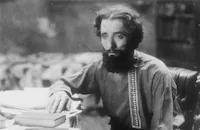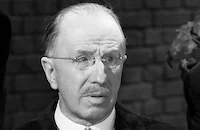The Four Horsemen of the Apocalypse

Brief Synopsis
Cast & Crew
Rex Ingram
Rudolph Valentino
Alice Terry
Pomeroy Cannon
Josef Swickard
Brinsley Shaw
Film Details
Technical Specs

Synopsis
Madariaga, a wealthy old cattle owner of Argentina who despises his German son-in-law, lavishes all his affections on Julio. After Madariaga's death, the estate is divided and all the family disperse to Europe: the von Hartrotts to Germany and the Desnoyers to Paris. Julio buys a castle on the Marne and opens a studio, where he entertains, paints pictures, and soon falls desperately in love with Marguerite Laurier, youthful wife of a jurist. War comes, Marguerite joins the Red Cross, and her husband enlists. Finding him blinded, she determines to resist the attentions of Julio. Spurred on by the words of a stranger, who invokes the Four Horsemen--War, Conquest, Famine, and Death--Julio enlists, and after distinguishing himself for bravery he is killed in an exchange with his cousin, an officer in the German Army.

Director
Rex Ingram
Cast

Rudolph Valentino

Alice Terry
Pomeroy Cannon

Josef Swickard
Brinsley Shaw

Alan Hale
Bridgetta Clark
Mabel Van Buren

Nigel De Brulier
Bowditch Turner
John Sainpolis
Mark Fenton
Virginia Warwick
Derek Ghent
Stuart Holmes

Jean Hersholt
Henry Klaus
Edward Connelly
Georgia Woodthorpe

Kathleen Key

Wallace Beery
Jacques D'auray
Curt Rehfeld
Harry Northrup
Claire De Lorez
Bull Montana
Isabelle Keith
Jacques Lanoe
Noble Johnson
Minnehaha

Arthur Hoyt
Beatrice Dominguez
Crew

Videos
Movie Clip


Film Details
Technical Specs

Articles
The Four Horsemen of the Apocalypse (1921)
The Four Horsemen of the Apocalypse is an epic tale of an Argentinean family who becomes divided and ends up fighting on opposite sides during WWI. The film, based on the novel by Vicente Blasco Ibanez, grew into a mammoth production: over $1 million was poured into it and over 12,000 people were involved. Yet the film's existence can be traced back to one woman, June Mathis. As the head of Metro's script department, Mathis, realizing the film potential of the best-selling novel, persuaded then-president Richard Rowland to buy the rights. She also convinced the studio to hire Ingram on as director; realizing her passion for the project, Metro also gave her screenwriting duties. As the final coup de grace, Mathis insisted on casting an unknown actor in the featured role of Julio. In a 1921 interview with famed columnist Louella Parsons, Valentino says of Mathis, "She discovered me. Anything I have accomplished I owe to her, to her judgment, to her advice and to her unfailing patience and confidence in me." Mathis had spotted Valentino in a bit part in the film Eyes of Youth (1919), and her instincts told her he was a star. Those instincts resulted in one of the most successful films of its time, grossing over $4 million, and catapulted "The Great Lover" into cinematic history as the first screen idol.
An Italian immigrant, Rodolfo Alfonzo Raffaelo Pierre Filibert Guglielmi di Valentina D'Antonguolla arrived in New York City in 1913, adopted the soon-to-be-famous name of Rudolph Valentino and struggled to support himself doing odd jobs like gardening, dishwashing and waiting tables. He was, however, a good dancer, which proved to be his break into movies via his friend and occasional dance partner Alla Nazimova. The tango scene from The Four Horsemen of the Apocalypse was embellished and expanded to optimally display Valentino's talents in the sensual dance. Since the role of Julio was a feature part, Valentino was originally paid $100 per week; this was soon increased to $350 per week. After the release of the film and the resulting "Valentino mania," Metro still refused to increase his salary to a starring player's rate. Metro may have been truly unaware of Valentino's massive potential, or perhaps they were wishfully hoping to keep him on at bargain basement prices. At any rate, Valentino called their bluff and moved over to Paramount, which quickly released The Sheik (1921), sealing Valentino's celebrity status. Rudy would star in nine more films before succumbing to peritonitis in 1926; his death sparked mass hysteria and near riots when fans learned the news.
During the filming of The Four Horsemen of the Apocalypse, however, Valentino was still new to the publicity game. Director Ingram found him one day on the back of the lot, posing for informal photographs. Unfortunately, the heroic image he was trying to project astride a horse was compromised by the saddle being on backwards, so Ingram kept a close eye on Valentino's publicity throughout the remainder of the production. Ingram also takes credit for extending the tango scene, claiming that he reused a scene from one of his earlier Universal pictures and transposed it into the Horsemen plot. Given Mathis' influence and initiative with the project, however, one is inclined to think that the scene was a cooperative effort at the very least. Ingram did have an expert crew to work with, led by editor Guy Whytock and cinematographer John Seitz. Whytock often worked with Ingram, and was well prepared to deal with the director's propensity to overshoot production.The Four Horsemen of the Apocalypse ended up with half a million feet of raw footage for Whytock to sort through. Seitz, nominated for his work on such films as Double Indemnity (1944), The Lost Weekend (1945), and Sunset Boulevard (1950), was a pioneer in his field with such contributions as the matte shot and his trademark usage of low-key lighting.
Although the presence of Valentino dominates The Four Horsemen of the Apocalypse, there are other actors of note featured. Alice Terry, the billed star as well as Ingram's wife, was a popular actress of her day. She would be cast in the next Ingram/Valentino flick rushed out in the same year before Rudy's jump to Paramount, The Conquering Power (1921). Alan Hale appears in a supporting role; he was perhaps best known as Errol Flynn's sidekick in numerous films, his role of Little John in several Robin Hood flicks, and as the father of Hale, Jr., who played the Skipper on the television series Gilligan's Island.
Director: Rex Ingram
Screenplay: June Mathis
Production Design: Joseph Calder, Amos Meyers
Cinematography: John F. Seitz
Film Editing: Grant Whytock
Original Music: Louis F. Gottschalk
Cast: Rudolph Valentino (Julio Desnoyers), Alice Terry (Marguerite Laurier), Alan Hale (Karl von Hartrott), Pomeroy Cannon (Madariaga).
BW-134m.
by Eleanor Quin

The Four Horsemen of the Apocalypse (1921)
Quotes
Is it not enough to lead my son into wild ways without teaching my daughter the tango?- Dona Luisa
Will you have the boy grow up like those glass-eyed, carrot-topped sharks of your sister's?- Madriaga
Trivia
This film was selected to the National Film Registry, Library of Congress, in 1995.
Rudolph Valentino signed onto the film for $350 a week, less than Wallace Beery earned for his small role as a German officer. Metro provided Valentino only with his Argentine gaucho costume and his French soldier's uniform. For the Parisian sequence, Valentino purchased more than twenty-five custom-fitted suits from a New York tailor, which he spent the next year paying for.
Prior to editing, the kiss at the end of the tango scene between Valentino and Dominguez took up seventy-five feet of film. The scene wasn't in the Ibanez novel, but was added by 'Rex Ingram' to show off Valentino's dancing skills.
Alice Terry wore a blonde wig during filming. She and Valentino spoke French in their scenes to make them more authentic to lip-readers.
President Warren G. Harding and Vice-President Calvin Coolidge, with their respective spouses, attended private screenings of the film.
Notes
Another adaption of the novel was produced by M-G-M in 1961. That version was directed by Vincente Minnelli and starred Glenn Ford and Ingrid Thulin (see AFI Catalog of Feature Films, 1961-70).

Miscellaneous Notes
Released in United States 1921
Released in United States March 1975
Selected in 1995 for inclusion in the Library of Congress' National Film Registry.
reels 11
Released in United States 1921
Released in United States March 1975 (Shown at FILMEX: Los Angeles International Film Exposition (Silent Film with Live Orchestral Accompaniment) March 13-26, 1975.)













